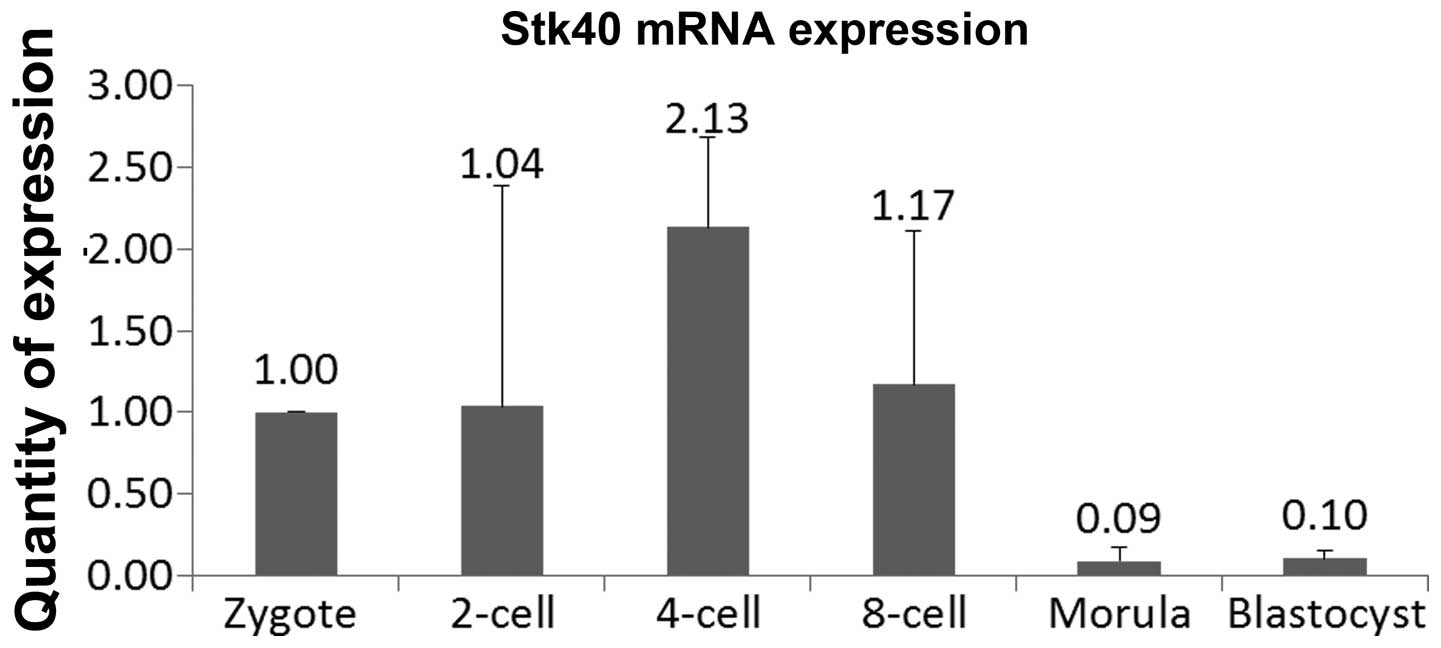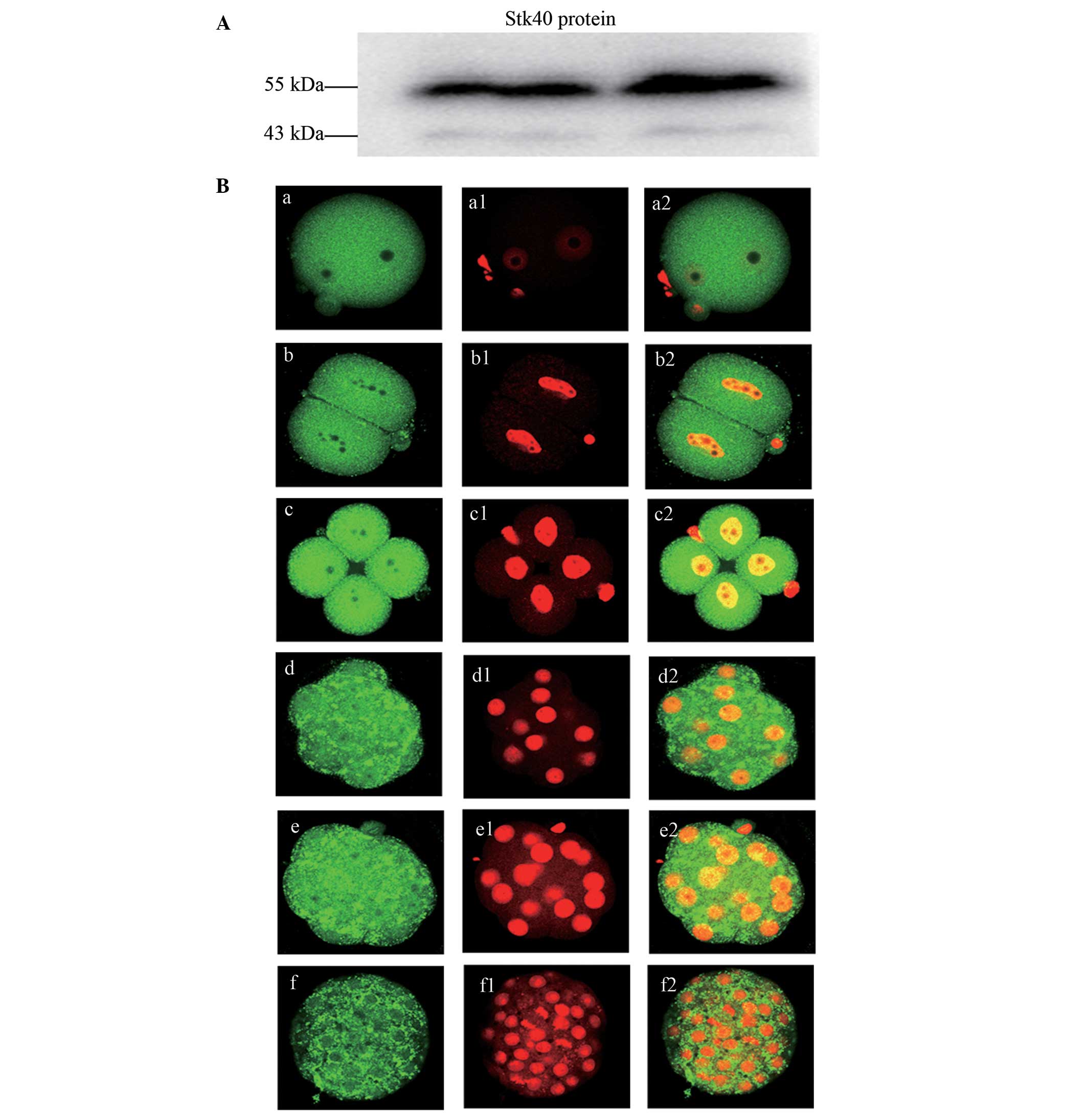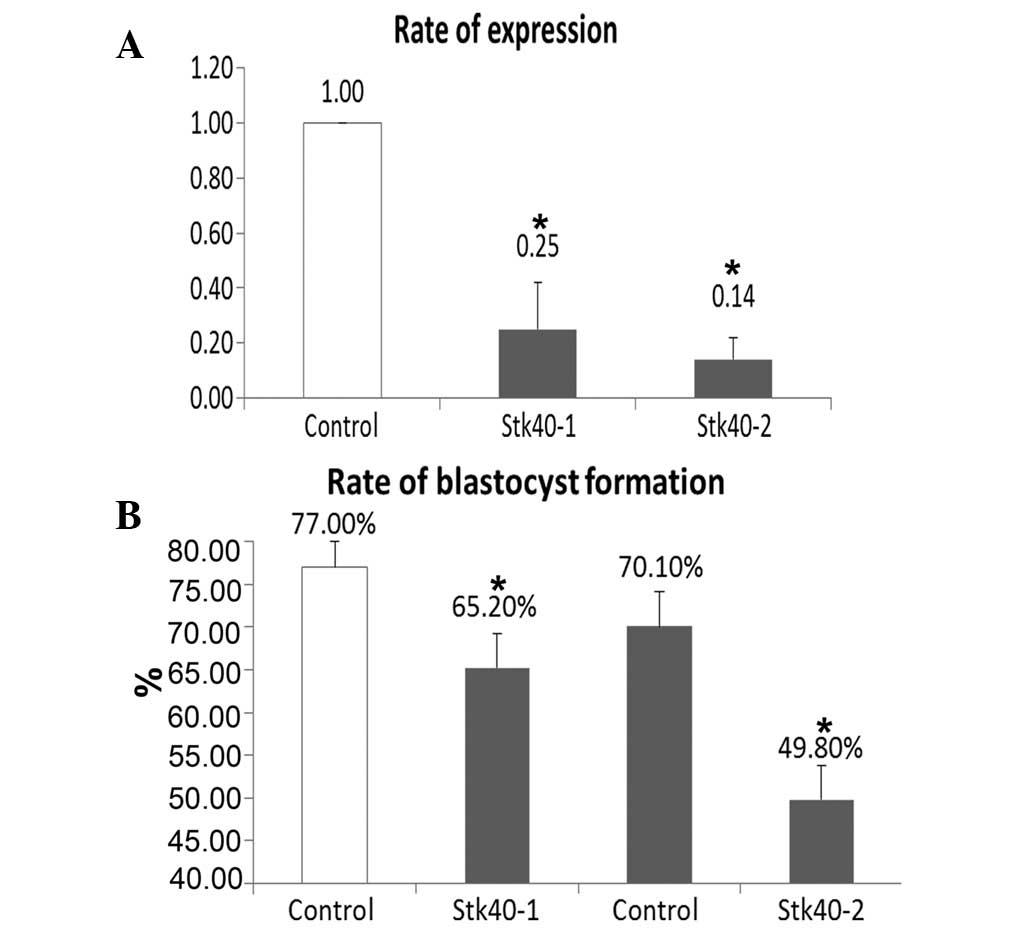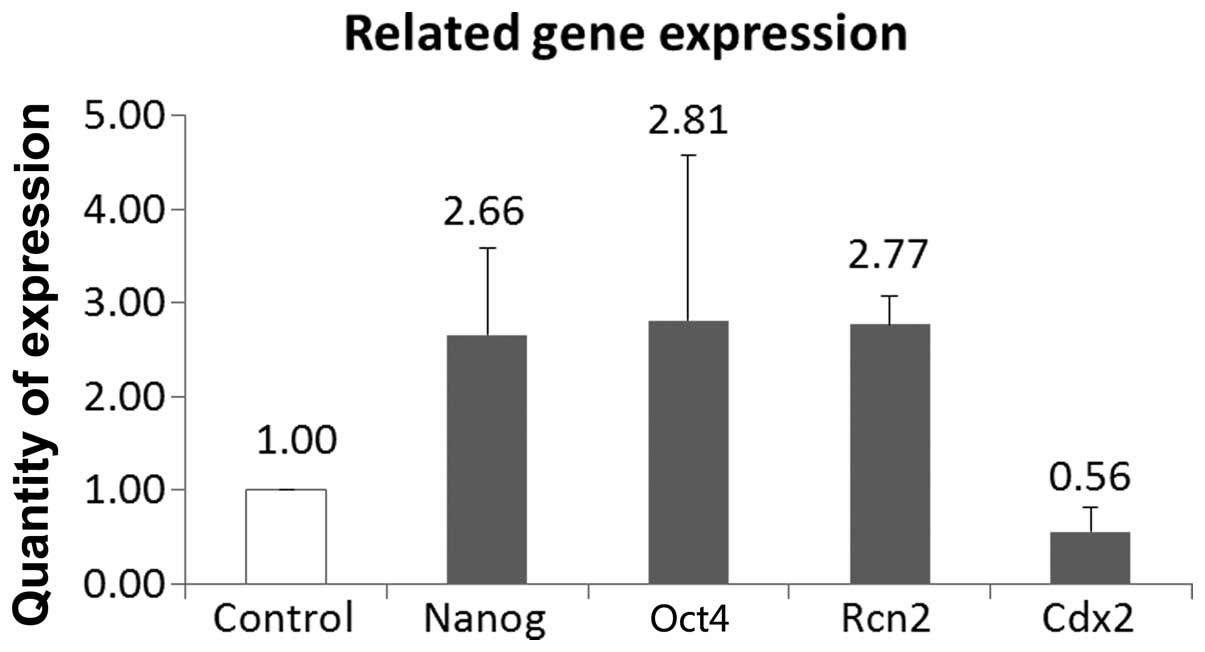Analysis of transcription factor Stk40 expression and function during mouse pre-implantation embryonic development
- Authors:
- Published online on: November 25, 2013 https://doi.org/10.3892/mmr.2013.1828
- Pages: 535-540
Abstract
Introduction
The development of mouse pre-implantation embryos involves substantial cell proliferation and differentiation, and cell lineages are established early during embryonic development. Various studies, over the past few years, have identified key transcription factor networks during mouse pre-implantation embryonic development (1–5). These transcription factors, including octamer-binding transcription factor 4 (Oct4), Sox2, Kruppel-like factor 4 (Klf4) and c-Myc have been demonstrated to reprogram somatic cells in vitro leading to the generation of pluripotent stem cells derived from mouse embryonic fibroblasts (6). Therefore, transcription factors are essential regulators of the transition from germ-cell-type to embryo-type gene expression and are key in determining cell characteristics (7). In addition, numerous studies have shown that epigenetic regulation is a decisive factor in pre-implantation embryo development (8,9) and each embryonic developmental stage is characterized by a specific epigenetic pattern (10). It has been determined that in vitro developmental block occurs in different species at different stages of embryonic development, which is concurrent with embryonic genome activation (11). The developmental block in mouse, bovine and human embryos occurs at the two-cell, four-cell and four- to eight-cell stages (12).
In clinically assisted reproduction practices, human embryos cultured in vitro are sensitive to developmental arrest and the completed blastocyst formation rate is only ~50% (13); however, the reasons for this are not well understood. Although improvements in in vitro culture conditions have greatly enhanced the embryo integrity, the in vitro fertilization (IVF) success rates are not ideal. Thus, increased knowledge of the molecular mechanisms regulating oogenesis, fertilization, cleavage, blastocyst formation and implantation is crucial for future assisted reproductive technology improvements. The Serine/threonine protein kinase 40 (Stk40) Stk40 gene has been identified previously, by a low density array analysis, to be one of the development-related transcription factors in mouse embryonic pre-implantation development. This gene was initially defined as a SINK-homologous serine/threonine kinase, designated as SHIK, which negatively regulates NF-κB and p53-mediated transcription (14). In a previous ChIP-chip assay, the promoter of Stk40 was demonstrated to associate with Oct4 as well as Sox2 and Nanog (15). In addition, it was shown that Stk40, a target gene of Oct4 transcription, was able to activate the extracellular signal-regulated kinase (ERK)/mitogen-activated protein kinase (MAPK) signaling pathway and induce embryonic stem cell differentiation into extraembryonic-endoderm (ExEn) cell lineages through reticulocalbin-2 (Rcn2) (16). However, its function and mechanism of gene regulation in early embryonic development remains to be further elucidated.
In the present study, the expression and localization of the Stk40 gene was investigated during mouse embryonic development. Downregulation of Stk40 indicated that this gene was essential in mouse embryogenesis, particularly in blastocyst formation. In addition, the results suggested an association between Stk40 and the ERK/MAPK signaling pathway.
Materials and methods
Chemicals
4-(2-hydroxyethyl)-1-piperazineethanesulfonic acid (HEPES)-buffered Chatot, Ziomet and Bavister (CZB) medium was purchased from Sigma-Aldrich (St. Louis, MO, USA), polyclonal Stk40 antibodies were purchased from Jingtiancheng Biotech Co., Ltd. (Beijing, China).
Embryo collection and culture
A total of 200 Imprinting control region (ICR) female mice (Shanghai Slac Labortory Animal Co., Ltd., Shanghai, China) were maintained in a controlled environment of 20–22°C and 12/12-h light/dark cycle, with 50–70% humidity and access to food and water ad libitum. Animal care and experimental procedures were conducted in accordance with the Animal Research Committee guidelines of the Nanjing Medical University (Nanjing, China). For the collection of zygotes, female ICR mice (age, 8 weeks) were injected with human chorionic gonadotropin and mated with ICR male mice shortly following the injection. After 15–17 h, zygotes were collected from the oviducts of the mice and transferred onto a HEPES-buffered CZB medium. Cumulus cells were dispersed by treatment with 1 mg/ml hyaluronidase in HEPES-CZB. Cumulus-free zygotes were washed with HEPES-CZB medium and cultured in CZB medium until they grew to the later early embryo stages at 37°C in a 5% CO2 atmosphere. The study was approved by the Ethical committee of Nanjing Normal University, Nanjing Maternity and Child Health Care Hospital Affiliated to Nanjing Medical University and of the Medical School of Nanjing University, Nanjing University (Nanjing, China).
Immunoblotting analysis
Immunoblotting was performed to analyze the valence of made-to-order Stk40 antibodies (Jingtiancheng Biotech Co., Ltd.). The ovary proteins of adult ICR mice were separated by sodium dodecyl sulfate-polyacrylamide gel electrophoresis and then electrophoresed onto polyvinylidene fluoride membranes. Following the transfer, the membranes were blocked in Tris-buffered saline with 0.1% Tween-20 (TBST) containing 5% skimmed milk for 2 h, followed by overnight incubation at 4°C with rabbit polyclonal anti-Stk40 antibodies (dilution, 1:500; NFB001; Jingtiancheng Biotech Co., Ltd.). Following three 10 min washes with TBST, the membranes were incubated for 1 h at 37°C with horseradish peroxidase-conjugated goat anti-rabbit IgG (dilution, 1:1000; Zhongshan Biotech, Beijing, China). The membranes were then processed using an enhanced chemiluminescence detection system (Model 920; Amersham Biosciences, Piscataway, NJ, USA).
Immunofluorescence and confocal microscopy
For staining of Stk40, the embryos were fixed in 4% paraformaldehyde in phosphate-buffered saline (PBS; pH 7.4) for ≥30 min at room temperature. Subsequent to permeabilization with 0.5% Triton X-100 at room temperature for 20 min, the embryos were incubated with 1% bovine serum albumin-supplemented PBS for 1 h and incubated overnight at 4°C with rabbit anti-Stk40 antibodies (dilution, 1:1000; Jingtiancheng Biotech Co., Ltd.). Following three 5 min washes with PBS containing 0.1% Tween-20 and 0.01% Triton X-100, the embryos were labeled with fluorescein isothiocyanate-conjugated goat anti-rabbit IgG (dilution, 1:100; Zhongshan Biotech) for 1 h at room temperature. Subsequent to another three washes in PBS containing 0.1% Tween-20 and 0.01% Triton X-100, the embryos were stained with propidium iodide (10 μg/ml in PBS). The embryos were mounted on glass slides and examined under a confocal laser scanning microscope (Zeiss LSM 510 META, Zeiss, Jena, Germany).
Stk40 short interfering RNA (siRNA) microinjection and in vitro culture
Stk40-siRNA (MSS232404, MSS232405 and MSS292686) was purchased from Invitrogen Life Technologies (Carlsdbad, CA, USA). MISSION® siRNA is a heterogeneous mixture of siRNAs that target the same mRNA sequence. This multiple silencing approach leads to highly specific and effective gene silencing. The Stk40-siRNA was stored at −20°C at a concentration of 200 ng/μl. Approximately 10 pl of individual siRNA was microinjected into the cytoplasm of the zygotes, which were cultured in CZB medium for further observation. The developmental status of each group was identified and analyzed using a Nikon Eclipse TE2000-S microscope.
Reverse-transcription polymerase chain reaction (real-time PCR)
The primer sequences of Stk40 and related transcription factors are shown in Table I. siRNA-injected and control oocytes were paired to assess the differences in the mRNA quantity. Total RNA extraction and reverse transcription were performed using an RNeasy Micro kit (Qiagen, Valencia, CA, USA), according to the manufacturer's instructions and oligo-dT was used as a primer. Real-time PCR analysis was conducted using Fast start Universal SYBR Green Master (Roche Diagnostics Co., Indiannapolis, IN, USA), with an ABI Prism 7500 System (Applied Biosystems, Foster City, CA, USA). We processed 15–30 embryos at a time and GAPDH was used as an endogenous control. The 2−ΔΔCt method was used to analyze relative changes in gene expression between the groups.
Statistical analysis
All experiments were repeated three times. Prior to significance analyses, all percentage data were subjected to Arcsine transformation. Data were analyzed with paired Student's t-tests and the χ2 test, using SPSS software (SPSS Inc., Chicago, IL, USA). Data are expressed as the mean ± standard error of the mean. P<0.05 and P<0.01 were considered to indicate a statistically significant difference.
Results
Expression pattern of Stk40 mRNA in early embryonic stages
Real-time PCR was used to detect Stk40 at different embryonic stages and compare its transcript levels between the stages. cDNA was synthesized from mRNA isolated at the zygote, 2-cell, 4-cell, 8-cell, morula and developing blastocyst stages. For sample analysis, the comparative 2−ΔΔCT method was used to quantify the real-time results for the Stk40 transcripts. All study groups were normalized with GAPDH references and the zygote stage served as the calibrator. Therefore, the efficiencies of target and reference gene detections were similar and the 2−ΔΔCT calculation method was used for relative quantification. Stk40 was expressed at the highest level in the four-cell stage, while the relative level of Stk40 mRNA in the morula or blastocyst stage was only one-tenth that observed at the zygote stage (Fig. 1).
Subcellular localization of Stk40 protein in early embryos
The specificity of antibody to the Stk40 protein was investigated by western blot analysis. The molecular weight of the anti-Stk40 antibody appeared between 43 and 55 kDa (~50 kDa) with mouse ovary samples (Fig. 2A). The subcellular localization of Stk40 protein in early mouse embryos was investigated. The fluorescent staining of Stk40 was observed equally in the cytoplasm and nuclei in all stages of the pre-implantation mouse embryos. However, the most prominent staining appeared in the four-cell stage (Fig. 2B).
Stk40 endoribonuclease-prepared siRNA microinjection and in vitro culture
The inhibitory effect of specific Stk40-targeting siRNA was confirmed using real-time PCR. The injection of the two different Stk40-specific siRNAs (Stk40-1 and Stk40-2) significantly reduced the level of Stk40 mRNA in mouse blastocysts (P<0.05; Fig. 3A). The development of one-cell zygotes in the Stk40 siRNA-injected groups was observably stunted compared with the non-silencing siRNA-injected groups at different time points including 2.5 days (4-cell stage), 3.5 days (morula stage) and 4.5 days (blastocyst stage). In particular, the blastocyst formation rates of the two Stk40-silenced groups showed a significant decrease compared with that of the non-silencing-siRNA injected control groups (Stk40-1 versus control: 65.2% and 77.0%, P<0.05; Stk40-2 versus control: 49.8% and 70.1%, respectively; P<0.05) (Fig. 3B).
Increase in Rcn2 expression in Stk40 silenced embryos
The levels of the pluripotency markers Oct4 and Nanog, the extraembryonic endoderm marker Rcn2 and the trophectoderm (TE)-specific gene Cdx2 were assessed using real-time PCR in Stk40-silenced embryos and compared with those in the non-silencing siRNA-injected embryos (negative controls). Stk40 siRNA-injected embryos showed significantly increased Rcn2 and decreased Cdx2 levels (Fig. 4). In every embryonic development stage of each group, at least 35 embryos were observed.
Discussion
In the present study, Stk40 levels were analyzed in early mouse embryos at different embryonic pre-implantation stages using real-time PCR. The results showed that Stk40 was expressed in all investigated stages; however, the expression level began to decrease markedly from the four-cell stage onwards. Previous studies in mice have demonstrated that the greatest alteration in transcription factor activities occurred between the one- and two-cell stages, at which time zygotic genome activation (ZGA) occurs. Moreover, basic transcription factors, which are the general components of transcription, increased transiently at the two-cell stage (7). These findings are consistent with data from the present study regarding the expression pattern of Stk40. Thus, the expression peak at the two-cell stage and the subsequent decline suggested that Stk40 may be important in the maternal-to-embryonic transition process. In addition, the subcellular localization of the Stk40 protein confirmed the results of the real-time PCR analysis and showed that there was a translation delay with the most prominent protein staining appearing in the four-cell stage. Furthermore, it was demonstrated that Stk40 downregulation by siRNA markedly decreased the rate of blastocyst formation.
It was observed that the Stk40 transcription factor was expressed in dynamic patterns following fertilization of the oocyte and may be important in embryonic pre-implantation development. Identification of critical regulatory genes is a crucial step in understanding early embryogenesis; thus, the mRNA levels of possible related genes were measured via real-time, following Stk40-specific siRNA microinjection. This included the pluripotency markers Oct4, Nanog, Rcn2 and Cdx2. The results showed that Oct4, Nanog and Rcn2 were upregulated and Cdx2 was downregulated following Stk40-specific siRNA microinjection.
Cell proliferation is an important event in early embryonic development and is largely affected by the regulation of diversified signaling pathways, such as the classic ERK/MAPK signaling pathway (2). This pathway is a critical regulator of cellular processes in adult and developing tissues (17), which exerts its biological effects predominantly through the highly selective activation of ERK1/2 (18). It has been suggested that Stk40 activated Erk1/2 through Rcn2 and participated in the ERK/MAPK pathway through Oct4 to control the ExEn lineage differentiation (16). According to the results of the present study, it was suggested that the interaction between Stk40 and the ERK/MAPK signaling pathway influenced the embryonic mouse pre-implantation development. Oct4 and Nanog are known to be pluripotency markers and exhibit restricted expression in pluripotent cell types (19,20). Previous studies indicated that Oct4 was present in all embryonic cells until the late blastocyst stage, gradually disappearing from the TE thereafter (21). Oct4 is highly expressed at the 1- and 2-cell stages in embryos, facilitating ZGA and enhancing maternal mRNA degradation (22). In the present study, the expression pattern of Stk40 was similar to that of Oct4 and, following Stk40 downregulation, increasing Oct4 expression levels appeared in a compensation pattern. Conversely, Nanog expression is initiated in the late stages of pre-implantation embryos and its mRNA is first detected at approximately the eight-cell stage (21). Thus, its expression pattern is opposite to that of Oct4 and Stk40. Notably, Nanog is also an activator of Oct4 through binding to the distal enhancer of Oct4 (19). The results indicated that Nanog expression was upregulated following Stk40 downregulation. This is consistent with a recent study, which demonstrated that Stk40 expression was gradually upregulated when Oct4 expression was rapidly silenced, as Nanog expression was downregulated during this process (16). However, the reciprocal interactions between Stk40 and Nanog remain to be fully evaluated.
It was demonstrated that Stk40 was incapable of promoting the extraembryonic endoderm differentiation when Rcn2 was knocked out (16). Rcn2 is a Ca2+-binding protein, known as an extraembryonic endoderm differentiation marker together with Gata6 and Dab2 (23). It was shown that the Stk40 downregulation increased the Rcn2 expression level ~3-fold compared with the control group, suggesting that Rcn2 may function downstream of Stk40; however, the correlation between Rcn2 and embryonic development arrest requires further investigation. Cdx2 is a known tumor repressor in intestinal epithelium (24). It was previously demonstrated that Cdx2 is involved in trophectoderm formation at the blastocyst stage in mice and the expression pattern of Cdx2 during pre-implantation stages is upregulated in 8–16-cell stage embryos (25). Moreover, inactivation of Cdx2 leads to embryonic pre-implantation lethality (26). Therefore Cdx2 was selected as a blastocyst formation marker for analyzing the interaction with Stk40 at the blastocyst stage. In the present study it was observed that Cdx2 expression was significantly decreased following Stk40 gene silencing, which significantly affected blastocyst formation. A previous study suggested that Cdx2 is essential for segregation of the inner cell mass and TE lineages at the blastocyst stage by ensuring repression of Oct4 and Nanog in the TE (27). Thus, it was speculated that low Cdx2 expression following Stk40 downregulation may have been the reason for Oct4 and Nanog upregulation. Although the correlation between Cdx2 and Stk40 was not directly demonstrated, it was suggested that once expression of these genes reached their threshold levels and an imbalance between them occurred, aberrant embryonic development is triggered.
In conclusion, it was suggested that the Stk40 transcription factor may be crucial in mouse embryonic pre-implantation development. Further study of transcription factors may provide a reliable molecular biological basis and molecular targeting candidates for improving the efficiency of in vitro embryo culture and enhancing the clinical outcome.
Acknowledgements
This study was financially supported by the National Natural Science Foundation of China (grant nos. 81100420 and 81270701), the Foundation of Nanjing Medical University (grant no. 2011NJMU210), the Natural Science Foundation of Jiangsu Province (grant no. BK2012520) and the Nanjing Medical Science and Technique Development Foundation (2010NJMU030).
References
|
Hamatani T, Carter MG, Sharov AA and Ko MS: Dynamics of global gene expression changes during mouse preimplantation development. Dev Cell. 6:117–131. 2004. View Article : Google Scholar : PubMed/NCBI | |
|
Miyanari Y and Torres-Padilla ME: Epigenetic regulation of reprogramming factors towards pluripotency in mouse preimplantation development. Curr Opin Endocrinol Diabetes Obes. 17:500–506. 2010. View Article : Google Scholar : PubMed/NCBI | |
|
Pantazis P and Bollenbach T: Transcription factor kinetics and the emerging asymmetry in the early mammalian embryo. Cell Cycle. 11:2055–2058. 2012. View Article : Google Scholar : PubMed/NCBI | |
|
Sasaki H: Mechanisms of trophectoderm fate specification in preimplantation mouse development. Dev Growth Differ. 52:263–273. 2010. View Article : Google Scholar : PubMed/NCBI | |
|
Winger Q, Huang J, Auman HJ, Lewandoski M and Williams T: Analysis of transcription factor AP-2 expression and function during mouse preimplantation development. Biol Reprod. 75:324–333. 2006. View Article : Google Scholar : PubMed/NCBI | |
|
Carey BW, Markoulaki S, Hanna J, et al: Reprogramming of murine and human somatic cells using a single polycistronic vector. Proc Natl Acad Sci USA. 106:157–162. 2009. View Article : Google Scholar : PubMed/NCBI | |
|
Kageyama S, Gunji W, Nakasato M, Murakami Y, Nagata M and Aoki F: Analysis of transcription factor expression during oogenesis and preimplantation development in mice. Zygote. 15:117–128. 2007. View Article : Google Scholar : PubMed/NCBI | |
|
Saitou M, Kagiwada S and Kurimoto K: Epigenetic reprogramming in mouse pre-implantation development and primordial germ cells. Development. 139:15–31. 2012. View Article : Google Scholar : PubMed/NCBI | |
|
Wu FR, Liu Y, Shang MB, et al: Differences in H3K4 trimethylation in in vivo and in vitro fertilization mouse preimplantation embryos. Genet Mol Res. 11:1099–1108. 2012. View Article : Google Scholar : PubMed/NCBI | |
|
Palini S, De Stefani S, Scala V, Dusi L and Bulletti C: Epigenetic regulatory mechanisms during preimplantation embryo development. Ann N Y Acad Sci. 1221:54–60. 2011. View Article : Google Scholar : PubMed/NCBI | |
|
Bettegowda A, Lee KB and Smith GW: Cytoplasmic and nuclear determinants of the maternal-to-embryonic transition. Reprod Fertil Dev. 20:45–53. 2008. View Article : Google Scholar : PubMed/NCBI | |
|
Memili E and First NL: Zygotic and embryonic gene expression in cow: a review of timing and mechanisms of early gene expression as compared with other species. Zygote. 8:87–96. 2000. View Article : Google Scholar : PubMed/NCBI | |
|
Zhang JQ, Li XL, Peng Y, Guo X, Heng BC and Tong GQ: Reduction in exposure of human embryos outside the incubator enhances embryo quality and blastulation rate. Reprod Biomed Online. 20:510–515. 2010. View Article : Google Scholar | |
|
Huang J, Teng L, Liu T, et al: Identification of a novel serine/threonine kinase that inhibits TNF-induced NF-kappaB activation and p53-induced transcription. Biochem Biophys Res Commun. 309:774–778. 2003. View Article : Google Scholar : PubMed/NCBI | |
|
Kim J, Chu J, Shen X, Wang J and Orkin SH: An extended transcriptional network for pluripotency of embryonic stem cells. Cell. 132:1049–1061. 2008. View Article : Google Scholar : PubMed/NCBI | |
|
Li L, Sun L, Gao F, et al: Stk40 links the pluripotency factor Oct4 to the Erk/MAPK pathway and controls extraembryonic endoderm differentiation. Proc Natl Acad Sci USA. 107:1402–1407. 2010. View Article : Google Scholar : PubMed/NCBI | |
|
Shvartsman SY, Coppey M and Berezhkovskii AM: MAPK signaling in equations and embryos. Fly (Austin). 3:62–67. 2009. View Article : Google Scholar : PubMed/NCBI | |
|
Rajkumar R, Konishi K, Richards TJ, et al: Genomewide RNA expression profiling in lung identifies distinct signatures in idiopathic pulmonary arterial hypertension and secondary pulmonary hypertension. Am J Physiol Heart Circ Physiol. 298:H1235–H1248. 2010. View Article : Google Scholar | |
|
Mitsui K, Tokuzawa Y, Itoh H, et al: The homeoprotein Nanog is required for maintenance of pluripotency in mouse epiblast and ES cells. Cell. 113:631–642. 2003. View Article : Google Scholar : PubMed/NCBI | |
|
Nichols J, Zevnik B, Anastassiadis K, et al: Formation of pluripotent stem cells in the mammalian embryo depends on the POU transcription factor Oct4. Cell. 95:379–391. 1998. View Article : Google Scholar : PubMed/NCBI | |
|
Dietrich JE and Hiiragi T: Stochastic patterning in the mouse pre-implantation embryo. Development. 134:4219–4231. 2007. View Article : Google Scholar : PubMed/NCBI | |
|
Foygel K, Choi B, Jun S, et al: A novel and critical role for Oct4 as a regulator of the maternal-embryonic transition. PLoS One. 3:e41092008. View Article : Google Scholar : PubMed/NCBI | |
|
Gerbe F, Cox B, Rossant J and Chazaud C: Dynamic expression of Lrp2 pathway members reveals progressive epithelial differentiation of primitive endoderm in mouse blastocyst. Dev Biol. 313:594–602. 2008. View Article : Google Scholar | |
|
Chawengsaksophak K, James R, Hammond VE, Köntgen F and Beck F: Homeosis and intestinal tumours in Cdx2 mutant mice. Nature. 386:84–87. 1997. View Article : Google Scholar : PubMed/NCBI | |
|
Wang QT, Piotrowska K, Ciemerych MA, et al: A genome-wide study of gene activity reveals developmental signaling pathways in the preimplantation mouse embryo. Dev Cell. 6:133–144. 2004. View Article : Google Scholar : PubMed/NCBI | |
|
Chawengsaksophak K, de Graaff W, Rossant J, Deschamps J and Beck F: Cdx2 is essential for axial elongation in mouse development. Proc Natl Acad Sci USA. 101:7641–7645. 2004. View Article : Google Scholar : PubMed/NCBI | |
|
Strumpf D, Mao CA, Yamanaka Y, et al: Cdx2 is required for correct cell fate specification and differentiation of trophectoderm in the mouse blastocyst. Development. 132:2093–2102. 2005. View Article : Google Scholar : PubMed/NCBI |













